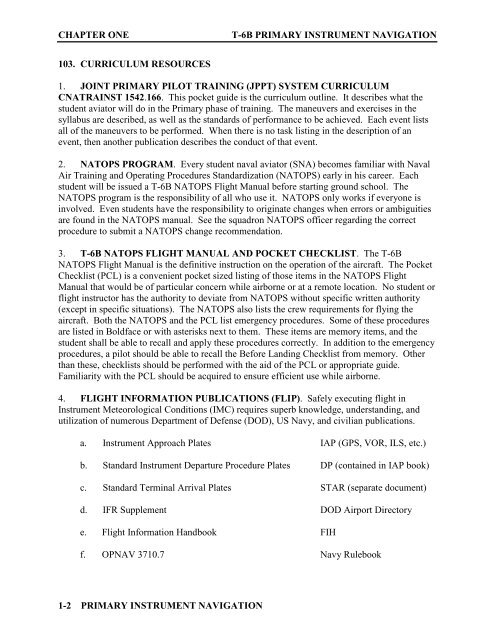Flight Training Instruction - Cnatra - U.S. Navy
Flight Training Instruction - Cnatra - U.S. Navy
Flight Training Instruction - Cnatra - U.S. Navy
You also want an ePaper? Increase the reach of your titles
YUMPU automatically turns print PDFs into web optimized ePapers that Google loves.
CHAPTER ONE T-6B PRIMARY INSTRUMENT NAVIGATION<br />
103. CURRICULUM RESOURCES<br />
1. JOINT PRIMARY PILOT TRAINING (JPPT) SYSTEM CURRICULUM<br />
CNATRAINST 1542.166. This pocket guide is the curriculum outline. It describes what the<br />
student aviator will do in the Primary phase of training. The maneuvers and exercises in the<br />
syllabus are described, as well as the standards of performance to be achieved. Each event lists<br />
all of the maneuvers to be performed. When there is no task listing in the description of an<br />
event, then another publication describes the conduct of that event.<br />
2. NATOPS PROGRAM. Every student naval aviator (SNA) becomes familiar with Naval<br />
Air <strong>Training</strong> and Operating Procedures Standardization (NATOPS) early in his career. Each<br />
student will be issued a T-6B NATOPS <strong>Flight</strong> Manual before starting ground school. The<br />
NATOPS program is the responsibility of all who use it. NATOPS only works if everyone is<br />
involved. Even students have the responsibility to originate changes when errors or ambiguities<br />
are found in the NATOPS manual. See the squadron NATOPS officer regarding the correct<br />
procedure to submit a NATOPS change recommendation.<br />
3. T-6B NATOPS FLIGHT MANUAL AND POCKET CHECKLIST. The T-6B<br />
NATOPS <strong>Flight</strong> Manual is the definitive instruction on the operation of the aircraft. The Pocket<br />
Checklist (PCL) is a convenient pocket sized listing of those items in the NATOPS <strong>Flight</strong><br />
Manual that would be of particular concern while airborne or at a remote location. No student or<br />
flight instructor has the authority to deviate from NATOPS without specific written authority<br />
(except in specific situations). The NATOPS also lists the crew requirements for flying the<br />
aircraft. Both the NATOPS and the PCL list emergency procedures. Some of these procedures<br />
are listed in Boldface or with asterisks next to them. These items are memory items, and the<br />
student shall be able to recall and apply these procedures correctly. In addition to the emergency<br />
procedures, a pilot should be able to recall the Before Landing Checklist from memory. Other<br />
than these, checklists should be performed with the aid of the PCL or appropriate guide.<br />
Familiarity with the PCL should be acquired to ensure efficient use while airborne.<br />
4. FLIGHT INFORMATION PUBLICATIONS (FLIP). Safely executing flight in<br />
Instrument Meteorological Conditions (IMC) requires superb knowledge, understanding, and<br />
utilization of numerous Department of Defense (DOD), US <strong>Navy</strong>, and civilian publications.<br />
a. Instrument Approach Plates IAP (GPS, VOR, ILS, etc.)<br />
b. Standard Instrument Departure Procedure Plates DP (contained in IAP book)<br />
c. Standard Terminal Arrival Plates STAR (separate document)<br />
d. IFR Supplement DOD Airport Directory<br />
e. <strong>Flight</strong> Information Handbook FIH<br />
f. OPNAV 3710.7 <strong>Navy</strong> Rulebook<br />
1-2 PRIMARY INSTRUMENT NAVIGATION
















